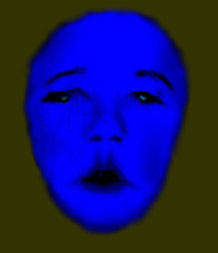Myotonic Dystrophy
|
|
 One of the more common generalized disorders with a prominent muscular component is myotonic dystrophy. It can appear in adults or in
older teenagers. There is also a congenital version (seen in the newborn) and a juvenile form as well.
One of the more common generalized disorders with a prominent muscular component is myotonic dystrophy. It can appear in adults or in
older teenagers. There is also a congenital version (seen in the newborn) and a juvenile form as well.
The facial appearance just about clinches the diagnosis, it is so characteristic. The lids droop, often with a bit of misconvergence and wandering of the eyes. The voice sounds nasal and whiny. Words are often hard to decipher as the connsonence drops out leaving a spoken stream of intonations such as "hyyy hoo hy uhhhern hoon" for "I took my brother home". Even before the age of speech the upper lips are tented and the lower drooped. The cheeks seem almost like waxen in their lack of contribution and that plus the thinned jaw musculatire produces a narrow face from forehead to chin.
Muscles, in general, are weak. Some eventually scar and become densely contracted. The feet tend to deform into clubbed posture.
About 20% of the cases are congenital and these are more severe. About half the time mothers carry huge water (polyhydramnios) as mother's water builds if the unborn infant can't swallow. Speech is delayed and learning may be slightly to severely impaired. When the joints just begin to form in utero, motion is expected (from muscles) to guide the shaping process. If anything interferes with that movement - such as myotonic dystrophy - then some joints may fail to form at all or form badly (a secondary condition called arthrogryposis). This is most apt to be seen in the feet as apparent clubbed feet.
Cardiac conduction defects are common. Muscles of the pharynx and swallowing muscles may be impaired. Gastrointestinal disturbances can be very severe and even catastrophic. The adult forms get cataracts of a certain kind. This is less frequent in the congenital cases. Diabetes occurs commonly as do other endocrine disturbances. Disturbances of potassium are not at all uncommon despite text books saying otherwise, and may be related to bowel causes.
The genetic markers for this syndrome are well described. A certain segment of DNA gets essentially stuttered when read - in that the code repeats itself - and does so more with each generation of female. For some reason male transmission of the gene seems to reduce the degree of code repetition. Thus the typical transmission is maternal. This oddity of worsening with each generation and appearing at a younger age of onset is also seen in other unrelated - we thought - conditions (fragile X and Huntington's Chorea).
The cell membranes seem to be overly resistant to chloride passage because of an overproduction of a protein called myotonin kinase. The sacs (sarcoplasmic reticulum) which hold calcium pooled ready for release in muscle cells seem to be amiss as well. Both suggest a cell membrane function disorder - one in which a protein which uses AMP to pump chloride does it badly.
Researchers in Rochester Medical Center have found a very unexpected link between the genes (DNA) and the defect as it manifests. It seems at the core of the disorder abnormal RNA is produced. That abnormal RNA gloms onto key proteins building up small globs inside the cell nucleus. As RNA does not need a double strand (the way DNA is double stranded - a right hand clasping a left hand) the Rochester folks synthesized a Right hand to clasp the errant RNA left hand only culprits. Like a zipper closing their active sites, the RNA is deactivated.